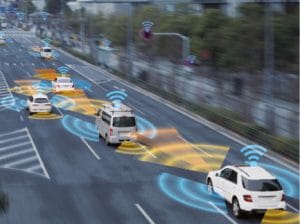
Connected and Automated Mobility services are one of the potential application areas of 5G that are currently being widely discussed. These services have a huge potential to make automotive mobility safer, more relaxing, and more economic.
Motivation
Among the multitude of potential vertical sectors in which 5G applications are currently considered, mobility-related applications are ranking close to the top. This is indicated by the number of trials which are currently ongoing in the various vertical sectors. According to the 5G Observatory Quarterly Report of September 2019, the vertical sector with the second-most number of trials in the EU is transport (28 trials), followed by automotive (20 trials) – only the media and entertainment sector has more trials. Thus, it is not surprising that Connected and Automated Mobility (CAM) is considered to be a flagship use case for 5G deployment along European transport paths within the European 5G vertical strategy.
Applications
A major application rapidly advancing in automotive is autonomous driving. This has been enabled so far at its various automation levels through vehicle-internal technology. Complementing it with 5G technology could accelerate the path towards fully autonomous driving. However, CAM is much more than autonomous driving. The 5G Automotive Vision White Paper, prepared by representatives from the automotive and the telecoms industry in the 5G PPP, lists further services, such as road safety and traffic efficiency services, including intersection collision risk warning, green light optimal speed advisory (GLOSA) and road hazard warnings. In addition, 5G can also foster the digitalization of transport and logistics and more intelligent navigation services. All such services and more are covered by the above-mentioned European 5G vertical strategy, which aims at creating complete ecosystems around vehicles, beyond the safety services targeted by the Cooperative-Intelligent Transport System (C-ITS) roadmap of Europe.
Cross-border corridors
For Connected and Automated Mobility services it is important that they seamlessly work across borders. In order to prepare for the deployment of 5G cross-border corridors for CAM, the EU Member States had signed a Letter of Intent in 2017 to intensify cross-border cooperation for testing and pre-deployment. In 5G PPP, three projects have been launched for testing of 5G CAM technology in cross border corridors – 5GCroCo, 5G CARMEN, and 5G-MOBIX, and another 3 to 4 EU projects will be launched via a Horizon 2020 Call in the 5G PPP, which closed in November 2019.
© Adobe Stock
Technology
When it comes to the technology required for deploying CAM services, 5G still seems to be lagging a bit behind. The most recent completed 3GPP specification – Rel. 15 – does not yet specify the Vehicle-to-Anything (V2X) communication using 5G new radio (NR); this is only planned for Rel. 16. Therefore current trials rely mainly on LTE-V2X equipment. Of course, a subset of CAM services can also be deployed using the eMBB specifications in 3GPP Rel. 15, and also equipment following the alternative ETSI ITS G5 standard could be used. However, for 5G communication from vehicle to other vehicles or to road-side units, a couple of years’ patience will probably be required.
Deployment
From the deployment perspective, we cannot expect that 5G Vehicle to Infrastructure / Vehicle to Network (V2I/V2N) will be deployed across the whole road network within a short period of time period. As we see current trials with a focus on motorways, it is expected that these and other busy roads – urban but also rural – will be the first roads where CAM services will be deployed. However, car manufacturers cannot wait until a large coverage of V2X along roads is achieved; neither can they easily deal with service interruption during a trip; especially if CAM is used for safety applications. We therefore might see the emergence of CAM services at hot-spot areas, or those relying on communication with gNodeB 5G Base Stations instead of Roadside Units.
Business viability
It still seems to be unclear, what a viable V2X ecosystem could look like. Which stakeholders will play a role? What will be their relationships? Who of them will contribute to the required investments into the network infrastructure and to what extent? The latter is an important aspect given that CAM services require a network with high reliability, high bitrate and very low latency.
The question then is what a viable business and revenue sharing model could look like. The 5G-PPP Automotive Working Group has tried to address this in its 5G Automotive White Paper published in February 2019. According to the paper, the deployment of a “5G digitized highway” is a main enabler, and it should be deployed only by private sector investments. In their cost and profit analysis the 5G-PPP Automotive Working Group concluded that, at least during the initial phase of service take-up and assuming a multi-network operator deployment, an active network sharing would be the most preferential option to keep costs at a reasonable level. The study expects a positive business case for roads with a high density of vehicles, which means that public investments are likely to be required, if CAM services shall also be available on less busy roads.
Further information:
5G PPP Automotive Working Group: Business Feasibility Study for 5G V2X Deployment, February 2019
– https://bscw.5g-ppp.eu/pub/bscw.cgi/d293672/5G{b28ae05319d94bff0b4d65c5a9f4524dd588360f05c61ef440e1608e0a1c4144}20PPP{b28ae05319d94bff0b4d65c5a9f4524dd588360f05c61ef440e1608e0a1c4144}20Automotive{b28ae05319d94bff0b4d65c5a9f4524dd588360f05c61ef440e1608e0a1c4144}20WG_White{b28ae05319d94bff0b4d65c5a9f4524dd588360f05c61ef440e1608e0a1c4144}20Paper_Feb2019.pdf
